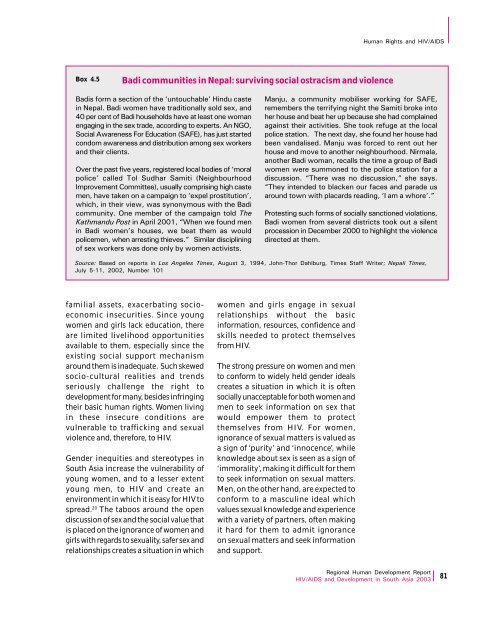Download Report - UNDP Asia-Pacific Regional Centre - United ...
Download Report - UNDP Asia-Pacific Regional Centre - United ...
Download Report - UNDP Asia-Pacific Regional Centre - United ...
Create successful ePaper yourself
Turn your PDF publications into a flip-book with our unique Google optimized e-Paper software.
Human Rights and HIV/AIDSBox 4.5Badi communities in Nepal: surviving social ostracism and violenceBadis form a section of the ‘untouchable’ Hindu castein Nepal. Badi women have traditionally sold sex, and40 per cent of Badi households have at least one womanengaging in the sex trade, according to experts. An NGO,Social Awareness or Education (SAE), has just startedcondom awareness and distribution among sex workersand their clients.Over the past five years, registered local bodies of ‘moralpolice’ called Tol Sudhar Samiti (NeighbourhoodImprovement Committee), usually comprising high castemen, have taken on a campaign to ‘expel prostitution’,which, in their view, was synonymous with the Badicommunity. One member of the campaign told TheKathmandu Post in April 2001, “When we found menin Badi women’s houses, we beat them as wouldpolicemen, when arresting thieves.” Similar discipliningof sex workers was done only by women activists.Manju, a community mobiliser working for SAE,remembers the terrifying night the Samiti broke intoher house and beat her up because she had complainedagainst their activities. She took refuge at the localpolice station. The next day, she found her house hadbeen vandalised. Manju was forced to rent out herhouse and move to another neighbourhood. Nirmala,another Badi woman, recalls the time a group of Badiwomen were summoned to the police station for adiscussion. “There was no discussion,” she says.“They intended to blacken our faces and parade usaround town with placards reading, ‘I am a whore’.”Protesting such forms of socially sanctioned violations,Badi women from several districts took out a silentprocession in December 2000 to highlight the violencedirected at them.Source: Based on reports in Los Angeles Times, August 3, 1994, John-Thor Dahlburg, Times Staff Writer; Nepali Times,July 5-11, 2002, Number 101familial assets, exacerbating socioeconomicinsecurities. Since youngwomen and girls lack education, thereare limited livelihood opportunitiesavailable to them, especially since theexisting social support mechanismaround them is inadequate. Such skewedsocio-cultural realities and trendsseriously challenge the right todevelopment for many, besides infringingtheir basic human rights. Women livingin these insecure conditions arevulnerable to trafficking and sexualviolence and, therefore, to HIV.Gender inequities and stereotypes inSouth <strong>Asia</strong> increase the vulnerability ofyoung women, and to a lesser extentyoung men, to HIV and create anenvironment in which it is easy for HIV tospread. 20 The taboos around the opendiscussion of sex and the social value thatis placed on the ignorance of women andgirls with regards to sexuality, safer sex andrelationships creates a situation in whichwomen and girls engage in sexualrelationships without the basicinformation, resources, confidence andskills needed to protect themselvesfrom HIV.The strong pressure on women and mento conform to widely held gender idealscreates a situation in which it is oftensocially unacceptable for both women andmen to seek information on sex thatwould empower them to protectthemselves from HIV. For women,ignorance of sexual matters is valued asa sign of ‘purity’ and ‘innocence’, whileknowledge about sex is seen as a sign of‘immorality’, making it difficult for themto seek information on sexual matters.Men, on the other hand, are expected toconform to a masculine ideal whichvalues sexual knowledge and experiencewith a variety of partners, often makingit hard for them to admit ignoranceon sexual matters and seek informationand support.<strong>Regional</strong> Human Development <strong>Report</strong>HIV/AIDS and Development in South <strong>Asia</strong> 2003 81
















